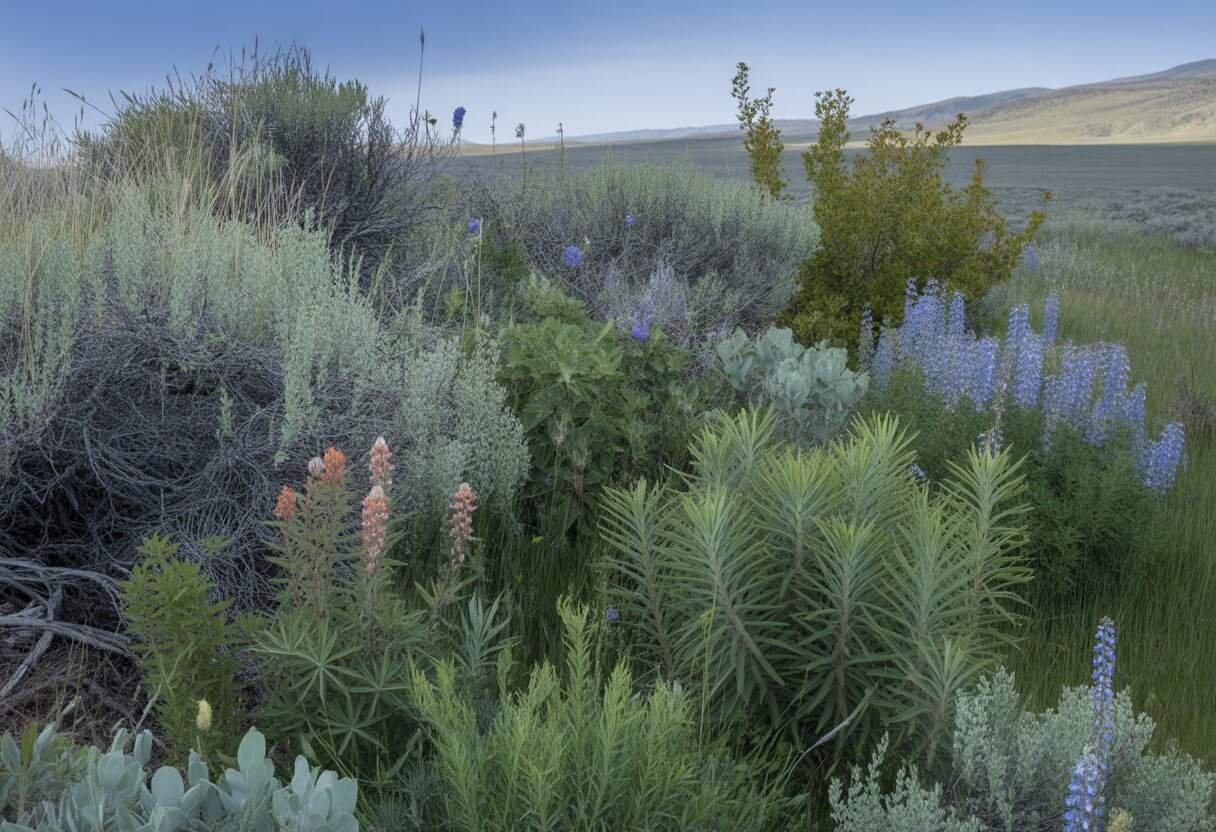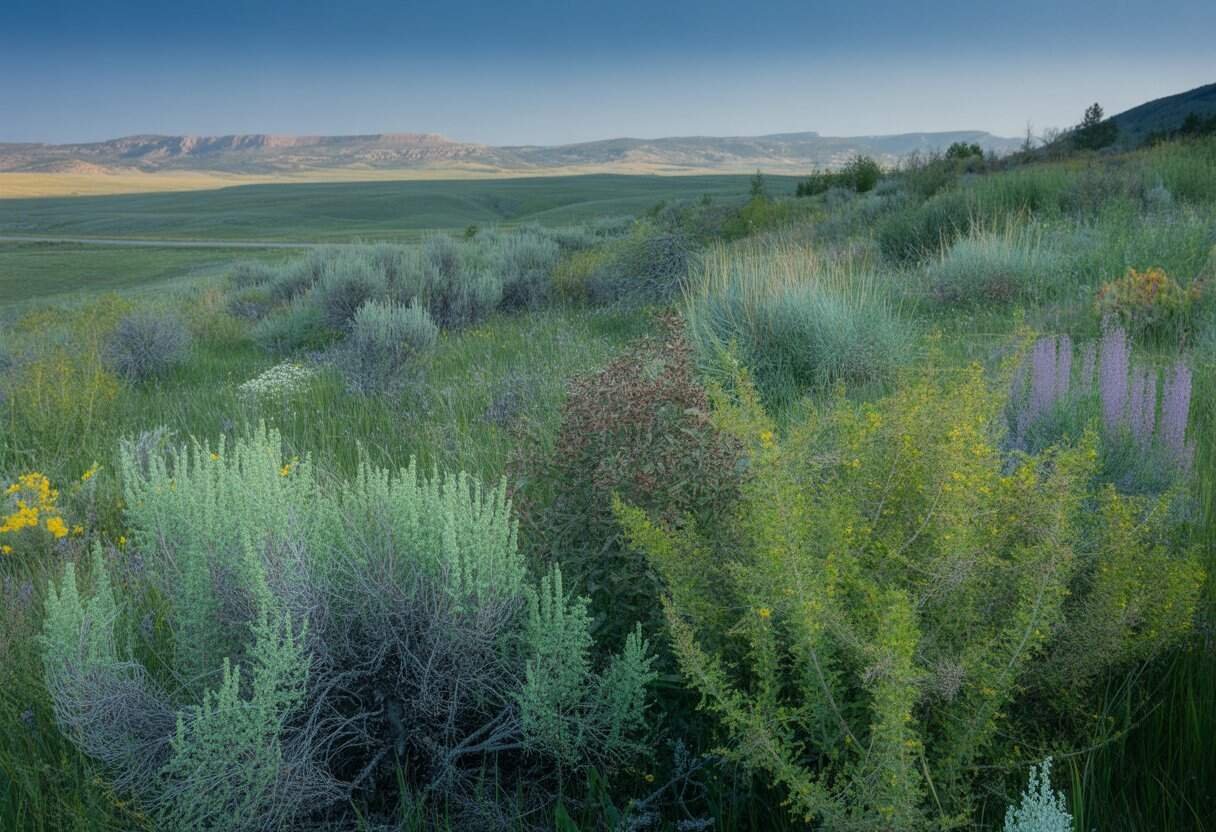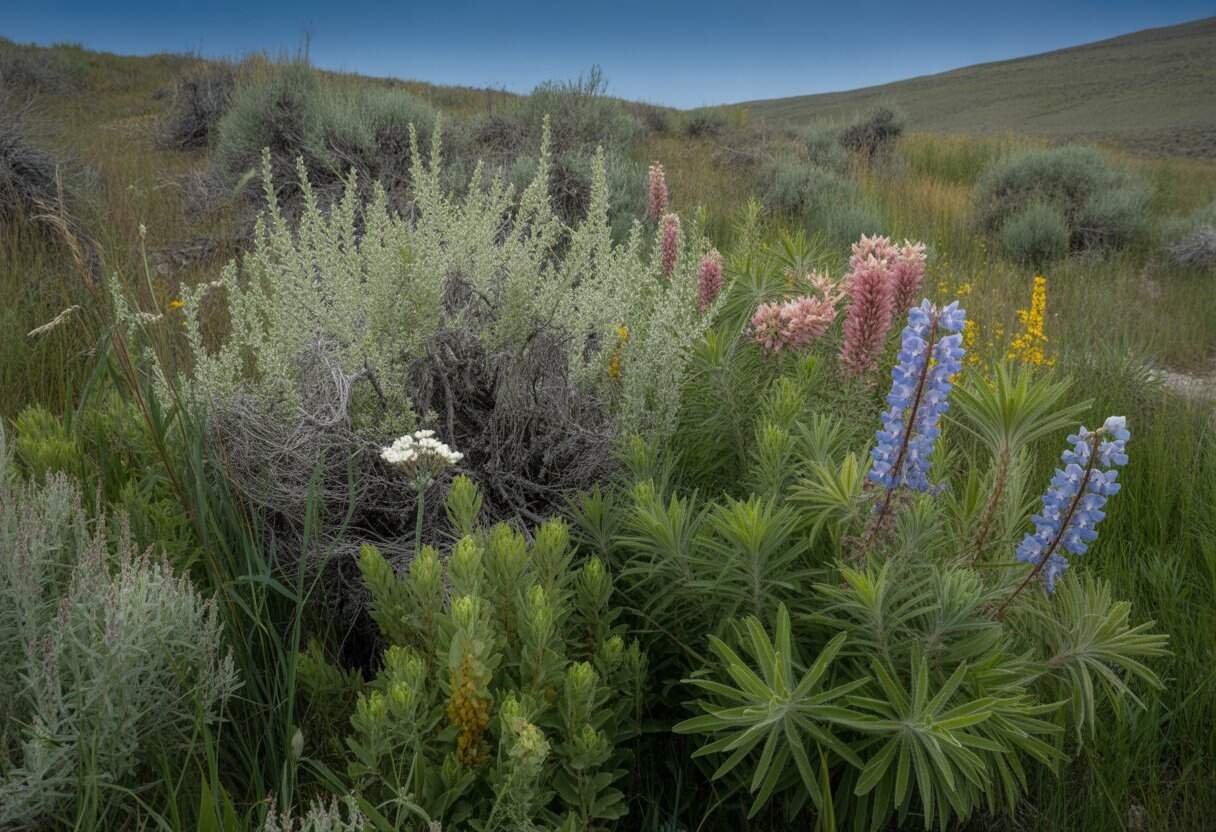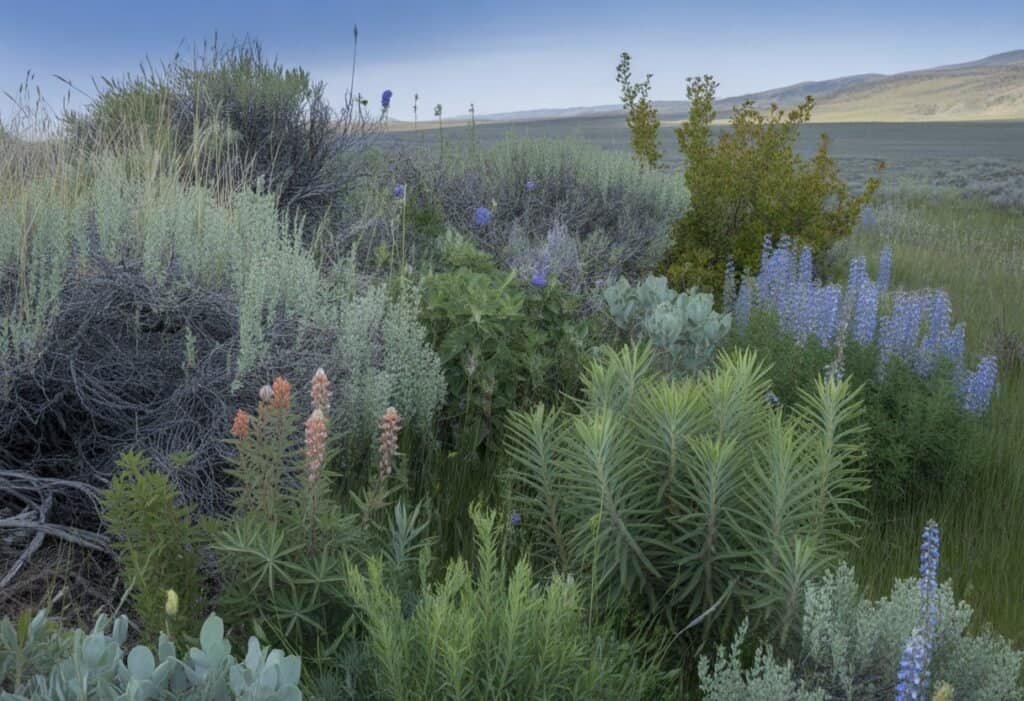Wyoming’s native plants are a diverse and resilient group of species. They have adapted to the state’s challenging climate and varied landscapes.
From the arid basins to alpine meadows, these plants have evolved special features to thrive in Wyoming’s harsh conditions. Native plants support local wildlife, conserve water, and maintain the unique character of Wyoming’s natural environment.

These indigenous species grow deep root systems to access scarce water and survive extreme temperature fluctuations. Wyoming boasts over 2,500 native plant species, including colorful wildflowers like the Indian Paintbrush (Wyoming’s state flower), hardy shrubs like sagebrush, and majestic trees such as the limber pine.
Many of these plants provide crucial habitat and food sources for wildlife.
Key Takeaways
- Wyoming native plants are adapted to local conditions, requiring less water and maintenance than non-native species.
- These indigenous plants support pollinators, birds, and other wildlife essential to Wyoming’s ecosystems.
- Using native plants in gardens and landscapes helps preserve Wyoming’s natural heritage and biodiversity.
Understanding Wyoming’s Ecosystems

Wyoming’s natural environment combines harsh conditions with remarkable diversity. The state’s unique geography creates distinct zones where specialized plant communities thrive.
Climate and Extreme Temperatures
Wyoming experiences some of the most dramatic temperature swings in the United States. Winter temperatures often plunge below -30°F, while summers can exceed 100°F in some regions.
These extremes create a challenging environment for plant life. Most native plants have developed specialized adaptations to survive.
Some grow low to the ground to avoid harsh winds. Others have deep root systems to access underground water sources.
The state receives limited precipitation, averaging only 10-15 inches annually. Mountain regions get more moisture, primarily as snow, creating different growing conditions than the drier plains.
Plants must also endure a short growing season in many areas. Frost is possible even in summer months at higher elevations.
Biodiversity and Flora
Wyoming hosts over 2,500 native plant species despite its harsh conditions. This diversity stems from the state’s varied landscapes and elevation changes.
Key Native Plant Groups:
- Wildflowers: Paintbrush, lupine, columbine
- Shrubs: Sagebrush, rabbitbrush, antelope bitterbrush
- Trees: Lodgepole pine, aspen, cottonwood
- Grasses: Bluebunch wheatgrass, needle-and-thread grass
Many Wyoming plants show impressive resilience. Sagebrush, the state’s signature plant, can live for over 100 years.
Native plants form the foundation of Wyoming’s food webs. They support diverse wildlife from pronghorn antelope to sage grouse.
Wyoming’s Unique Habitats
Wyoming contains several distinct ecosystems. Each supports specialized plant communities.
Sagebrush Steppe covers nearly one-third of Wyoming. This vast ecosystem features sagebrush and drought-resistant grasses.
Many plants here have silvery or hairy leaves to conserve water and reflect intense sunlight.
Alpine Zones exist above 10,000 feet in Wyoming’s mountains. Plants grow in tight clusters to withstand fierce winds and short growing seasons.
Cushion plants, alpine forget-me-nots, and hardy grasses dominate these areas.
Riparian Areas along rivers support water-loving plants like cottonwoods and willows. These zones make up less than 1% of Wyoming’s land but contain nearly 80% of its plant diversity.
Forests vary from lodgepole pine stands to mixed conifer forests. Understory plants adapt to low light conditions beneath the tree canopy.
Characteristics of Wyoming Native Plants

Wyoming native plants possess unique traits that help them thrive in the state’s challenging environments. These plants have developed specific adaptations to handle harsh conditions.
Adaptations to Drought and Soil
Wyoming native plants have evolved remarkable drought tolerance mechanisms. Many species develop deep root systems that can access water far below the surface during dry periods.
These roots may extend 15-20 feet underground, compared to the 1-2 feet typical of non-native plants.
Native plants like sagebrush and prickly pear cactus have specialized leaves that reduce water loss. Thick, waxy coatings or tiny hairs on leaves help reflect sunlight and trap moisture.
Some plants shed leaves during extreme drought to conserve resources.
These plants thrive in Wyoming’s low-organic matter soils. They require minimal fertilization, as they’ve adapted to extract nutrients efficiently from poor soil conditions.
Nitrogen-fixing plants like lupines and Wyoming pea improve soil quality by adding organic matter naturally.
Diversity of Plant Types
Wyoming’s native flora includes an impressive variety of growth forms. The state hosts over 2,500 native plant species ranging from tiny alpine flowers to large conifers.
Wildflowers like Indian paintbrush and the western prairie fringed orchid add vibrant colors to the landscape. These species often bloom in synchronized patterns to maximize pollination.
Shrubs such as big sagebrush and rabbit brush form the backbone of many Wyoming plant communities. They provide crucial wildlife habitat and stabilize soil against erosion.
Grasses represent another important plant type. Species like blue grama and Idaho fescue dominate many areas.
These drought-resistant grasses have developed specialized leaf structures that curl inward during dry periods.
Seasonal Growth Patterns
Wyoming native plants follow distinct seasonal rhythms adapted to the state’s short growing season. Many complete their entire life cycles within 60-90 days.
Spring Growth Burst:
- Early bloomers emerge as soon as snow melts
- Quick germination and growth when moisture is available
- Energy storage in roots and bulbs for future seasons
Summer brings peak flowering for many species. Plants maximize photosynthesis during long daylight hours while conserving water.
Some species enter dormancy during the hottest periods. This strategy, called “summer dormancy,” helps them survive dry spells.
Fall triggers preparation for winter. Plants redirect energy to roots and develop cold-hardy structures.
Many native species require winter’s cold period (vernalization) to trigger spring growth. This adaptation prevents premature sprouting during brief warm spells.
Key Native Plant Families in Wyoming
Wyoming’s diverse landscapes host several distinct plant families. These native plants form the backbone of Wyoming’s ecosystems, from colorful mountain meadows to expansive prairies.
Wildflowers and Notable Species
The Asteraceae (sunflower) family dominates Wyoming’s wildflower scene. Wyoming’s state flower, the Indian Paintbrush (Castilleja linariaefolia), belongs to the Orobanchaceae family and displays vibrant red-orange blooms from May through August.
Penstemons (Plantaginaceae family) thrive in Wyoming’s dry conditions with over 20 native species. Their tubular flowers attract important pollinators like bees and hummingbirds.
The delicate Wyoming Fairy Slipper (Calypso bulbosa) grows in moist forest areas. Hardy Blanketflowers (Gaillardia) brighten prairie landscapes with yellow and red blooms.
Alpine areas showcase unique species like Sky Pilot (Polemonium viscosum) and Alpine Forget-me-not (Myosotis alpestris). These plants survive harsh conditions at high elevations.
Grasses and Groundcovers
Native grasses form the foundation of Wyoming’s prairie ecosystems. Blue Grama (Bouteloua gracilis) and Buffalo Grass (Bouteloua dactyloides) create drought-resistant groundcovers that once supported vast bison herds.
The Poaceae family contributes key species like Western Wheatgrass (Pascopyrum smithii), Wyoming’s state grass. This blue-green perennial grows 1-3 feet tall and provides crucial wildlife forage.
Common Native Grasses in Wyoming:
- Needle-and-Thread (Hesperostipa comata)
- Indian Ricegrass (Achnatherum hymenoides)
- Little Bluestem (Schizachyrium scoparium)
- Prairie Junegrass (Koeleria macrantha)
Sedges and rushes from the Cyperaceae and Juncaceae families thrive in Wyoming’s wetland areas. They help prevent erosion along waterways.
Shrubs and Trees
Sagebrush (Artemisia tridentata) defines Wyoming’s landscape, covering millions of acres. This aromatic shrub provides essential habitat for sage grouse and over 350 other wildlife species.
The Rosaceae family contributes important shrubs like Chokecherry (Prunus virginiana) and Wild Rose (Rosa woodsii). These shrubs produce berries valuable to wildlife and historically to indigenous peoples.
Quaking Aspen (Populus tremuloides) creates distinctive white-trunked groves in Wyoming’s mountains. These trees form the largest known living organisms through their connected root systems.
In higher elevations, conifers dominate, including Lodgepole Pine (Pinus contorta), Engelmann Spruce (Picea engelmannii), and Subalpine Fir (Abies lasiocarpa). At lower elevations, Cottonwoods (Populus spp.) mark riparian corridors along Wyoming’s rivers and streams.
Noteworthy Wyoming Native Wildflowers
Wyoming’s landscape bursts with colorful native wildflowers that have adapted to the state’s unique climate and geography. These plants provide essential habitat for pollinators and showcase the rich botanical diversity found across Wyoming’s mountains, plains, and basins.
Indian Paintbrush
Indian Paintbrush (Castilleja) stands as Wyoming’s official state flower, recognized since 1917. This vibrant wildflower displays fiery red, orange, or yellow bracts that appear to be painted with bright colors.
Several species grow throughout Wyoming, thriving at different elevations from sagebrush plains to alpine meadows. Wyoming Indian Paintbrush (Castilleja linariifolia) is particularly common.
These plants are hemiparasitic. They attach their roots to neighboring plants to extract water and nutrients, an adaptation that helps them survive in Wyoming’s harsh conditions.
Indian Paintbrush typically blooms from May through August. Native Americans used these plants medicinally for treating burns and joint pain.
The bright clusters make them easy to spot against Wyoming’s landscape.
Showy Milkweed and Asclepias speciosa
Showy Milkweed (Asclepias speciosa) grows throughout Wyoming in meadows, along roadsides, and in disturbed areas. This sturdy perennial reaches 2-4 feet tall with broad, grayish-green leaves.
Its distinctive pink to purple flower clusters appear from June to August. The blooms release a sweet fragrance that attracts numerous pollinators.
The complex flower structure features hoods and horns that make pollination a specialized process.
Showy Milkweed serves as critical habitat for monarch butterflies. Their caterpillars feed exclusively on milkweed plants, which contain compounds that make the insects toxic to predators.
Indigenous peoples used the milky sap for medicinal purposes. The silky floss from seed pods was traditionally used for insulation and stuffing.
Bitter dogbane (Apocynum androsaemifolium), a related plant, often grows alongside milkweed in Wyoming.
Columbian Monkshood and Aconitum columbianum
Columbian Monkshood (Aconitum columbianum) features distinctive purple-blue hooded flowers that resemble monks’ cowls. This striking wildflower grows 2-6 feet tall in moist mountain meadows and along streams.
All parts of this plant contain powerful alkaloids that are highly toxic. Early settlers and indigenous peoples knew to avoid it for consumption but sometimes used minute amounts for specific medicinal purposes.
Columbian Monkshood blooms from June through September in Wyoming’s mountains. Its unique flower shape evolved to attract bumblebees, which are strong enough to push through the hood to reach nectar.
This plant often grows alongside red windflower (Anemone multifida) in Wyoming’s higher elevations. Both species prefer similar moist habitats in partially shaded areas of mountain forests.
Other Iconic Wildflowers
Wyoming’s diverse landscapes support many remarkable native wildflowers. Pale agoseris (Agoseris glauca) displays sunny yellow flowers on grasslands and mountain meadows from May through August.
Nodding onion (Allium cernuum) has drooping clusters of pink to lavender flowers. Its edible bulbs and leaves taste mildly of onion, and indigenous peoples used them in their diets.
Rock jasmine (Androsace septentrionalis) grows in rocky areas with tiny white flowers that bloom early in spring. This small plant thrives where few others can survive.
Elegant death camas (Anticlea elegans) produces creamy white flower clusters but contains toxic alkaloids. Early settlers sometimes confused it with edible camas, which led to its ominous name.
Selecting and Planting Native Species in Wyoming Gardens
Wyoming native plants add beauty and resilience to home landscapes. They support local ecosystems and need less maintenance than non-native plants.
Choosing Drought Tolerant Species
Wyoming’s semi-arid climate requires plants that can thrive with little water. Choose species like Wyoming sagebrush, prairie coneflower, and blanketflower that naturally adapt to limited rainfall.
Top drought-resistant natives for Wyoming gardens:
- Prairie smoke (Geum triflorum)
- Sulphur flower (Eriogonum umbellatum)
- Rocky Mountain penstemon (Penstemon strictus)
- Fringed sage (Artemisia frigida)
- Prairie zinnia (Zinnia grandiflora)
These plants grow deep roots to reach moisture far below the surface. This adaptation helps them survive dry spells without extra watering.
Select plants suited to your specific location in Wyoming. Plants from higher elevations may not thrive in lower basins, and vice versa.
Soil Preparation and Organic Matter
Wyoming soils range from clay-heavy to sandy. Test your soil before planting to understand its qualities.
Most native plants prefer well-draining soil. To improve heavy clay, add:
- Composted pine bark
- Coarse sand
- Leaf mulch
Mix organic matter 4-6 inches deep into planting areas. This improves drainage while keeping enough moisture for native plants.
Avoid using rich compost for most natives. Many Wyoming species grow best in nutrient-poor soils.
Spread a 2-3 inch layer of mulch around plant stems, but keep it from touching them. Mulch conserves moisture, suppresses weeds, and slowly adds organic matter to the soil.
Integrating Native Plants in Landscapes
Group native plants by their water and light needs to create attractive gardens. This method, called hydrozoning, lets each plant thrive in the right spot.
Try vertical layering with:
- Ground covers like kinnikinnick
- Mid-height plants such as prairie coneflower
- Taller species like serviceberry or chokecherry
Native plants work well in both formal and informal designs. Use native grasses like blue grama for structured gardens, or cluster plants as they grow together in the wild for a natural look.
Add native plants gradually to existing landscapes. Replace struggling non-natives with hardy Wyoming species that need less care.
Ecological and Conservation Benefits
Wyoming native plants offer important environmental benefits. These species form the backbone of healthy ecosystems across the state.
Supporting Biodiversity
Wyoming’s native plants create the foundation for biodiversity. They evolved alongside local insects, birds, and mammals, forming relationships that non-native plants cannot match.
Native plant communities support 5-10 times more species than areas with mostly non-native plants. For example, the Wyoming sagebrush ecosystem provides habitat for over 350 plant and animal species.
Many Wyoming natives, like the Wyoming Paintbrush (Castilleja linariifolia), form special relationships with native pollinators. Some need specific soil fungi to thrive, building a web of interdependence.
Native plant diversity helps ecosystems withstand climate extremes. Different species respond in their own ways to drought, fire, and temperature shifts, keeping ecosystems working during stress.
Ecosystem Services
Wyoming native plants deliver key ecosystem services. Their deep roots prevent soil erosion and help the land handle Wyoming’s strong winds.
Prairie Junegrass roots can reach 15 feet underground, holding soil in place. These roots also improve water infiltration, reduce flooding, and boost groundwater recharge.
Native plants need little maintenance. Once established, they require:
- Minimal or no extra water
- No fertilizers or pesticides
- Limited pruning or other care
Wyoming’s native flora also stores carbon well. Grassland species keep about 30% of their biomass underground, locking carbon in the soil for decades.
Wildlife Habitat Enhancement
Wyoming’s native plants provide essential habitat for wildlife year-round. They offer shelter, nesting materials, and food timed to animal life cycles.
Sagebrush supplies 90% of the winter diet for pronghorn and mule deer in many areas. Native berries like chokecherry and buffaloberry feed bears as they prepare for hibernation.
Many Wyoming birds rely on specific native plants. The Greater Sage-Grouse needs sagebrush for 80% of its diet and cannot survive without large sagebrush habitats.
Native plant gardens and restoration projects create wildlife corridors in developed areas. Even small native patches in towns support monarch butterflies, native bees, and songbirds.
Research, Education, and Community Resources
Wyoming’s native plants benefit from strong research, community programs, and education. These resources help preserve plant diversity and connect residents with their natural heritage.
Role of the University of Wyoming
The University of Wyoming leads native plant research in the state. Their Botany Department studies Wyoming’s diverse flora and how plants adapt to the harsh climate.
The Berry Biodiversity Conservation Center houses the Rocky Mountain Herbarium, which holds over 825,000 plant specimens. Researchers use this collection to track plant distribution and set conservation priorities.
UW’s Biodiversity Institute offers research grants for native plant projects. These grants support work on rare species, habitat mapping, and climate change impacts.
Faculty members publish findings in scientific journals, expanding global knowledge of high-elevation and drought-resistant plants. Their research helps land managers protect ecosystems.
Community Initiatives
Wyoming Plant Conservation Program works with landowners to create native plant reserves on private land. These partnerships have protected over 5,000 acres of native habitat in the past decade.
Local garden clubs sponsor native plant sales each spring. These events give residents access to locally-adapted species and reduce use of invasive ornamentals.
Notable Community Programs:
- Wyoming Native Plant Society’s citizen science network
- Master Gardener demonstration gardens in all 23 counties
- Annual Wyoming Wildflower Week each June
- Native seed collection volunteer programs
These grassroots efforts help conservation become part of daily life in Wyoming. They let residents actively protect their botanical heritage.
Educational Outreach
Wyoming schools now include native plant education in science classes. Students learn to identify local species and their ecological roles through field trips and classroom activities.
The Wyoming Native Plant Society offers free workshops year-round. These sessions teach plant identification, propagation, and landscape design with native species.
Field guides for Wyoming regions help hikers and outdoor enthusiasts recognize native plants. “Plants of the Rocky Mountains” and “Wyoming Wildflowers” are popular pocket guides.
Online platforms like WyoPlants.org give easy access to native species information. Their searchable database lists over 2,500 Wyoming native plants with photos and habitat details.
Educational signs along trails and in parks highlight native plant communities. These signs explain the relationships between plants, wildlife, and human activities.
Frequently Asked Questions
Wyoming’s native plants offer beauty, sustainability, and ecological benefits. These plants have adapted to the state’s unique climate and soils over thousands of years.
What are some native plants commonly found in Wyoming’s landscapes?
Wyoming’s landscapes feature many native plants adapted to harsh conditions. Blue flax shows delicate blue flowers and thrives in dry areas with little care.
Wyoming big sagebrush dominates many regions and provides habitat for wildlife like sage grouse. Its silver-gray leaves and strong aroma make it easy to recognize.
Prairie smoke adds feathery pink seed heads to grasslands. Blanketflower brings bright yellow and red blooms that attract pollinators all summer.
How can I identify native plants and shrubs specific to Wyoming?
To identify plants, observe leaf arrangement, flower structure, and growth habit. Wyoming-specific field guides offer detailed descriptions and images.
The Wyoming Native Plant Society holds workshops and field trips to teach identification skills. Their website has resources tailored to Wyoming’s ecosystems.
Mobile apps like iNaturalist let users photograph plants and get expert identification help. The University of Wyoming Extension also provides fact sheets for common natives.
What are the best native Wyoming plants for use in home landscaping?
Penstemons are top choices for Wyoming gardens, with tubular flowers in blue, purple, and red. These drought-tolerant perennials attract hummingbirds and need little care.
Prairie coneflower offers golden blooms from mid-summer through fall and resists drought well. Native grasses like blue grama and Idaho fescue add texture and need little water.
Serviceberry shrubs produce white spring flowers, edible berries, and colorful fall leaves. They support wildlife and adapt to many Wyoming conditions.
Can you provide images and descriptions for native plants in Wyoming?
The Wyoming Plant Atlas has photos and detailed descriptions of native species. The database covers habitat preferences, bloom times, and identifying features.
The Wyoming Native Plant Society publishes guides with quality images and descriptions. Their materials highlight features that help tell similar species apart.
University extension websites offer photo galleries of Wyoming natives by plant type and growing conditions. These resources include close-up images of flowers, leaves, and growth habits.
What native flowers are most prevalent in Wyoming?
Wyoming’s mountains have colorful wildflowers like Indian paintbrush, the state flower with red bracts. Alpine sunflowers brighten high elevations with large yellow blooms.
Prairie areas feature purple coneflowers, black-eyed Susans, and wild bergamot. These flowers give nectar to native pollinators during the growing season.
Desert regions display hardy bloomers like evening primrose, scarlet globemallow, and prickly pear cactus flowers. These species thrive with little rain and strong sun.
Where can I find a geographical distribution map of native plants in Wyoming?
The Rocky Mountain Herbarium maintains detailed distribution maps of Wyoming’s plant species. Their database shows where specific plants grow in different ecological regions.
Wyoming Flora is an online resource with interactive maps of plant distributions. Users can search by county, elevation range, or ecosystem type.
The USDA PLANTS Database provides Wyoming-specific distribution information. Their maps show county-level presence of native species and update regularly with new field observations.


